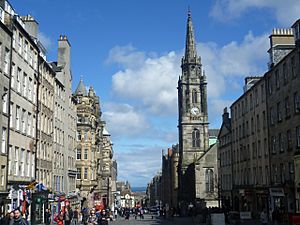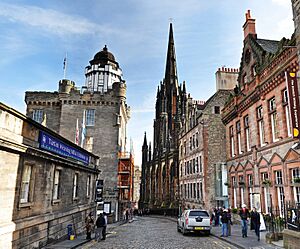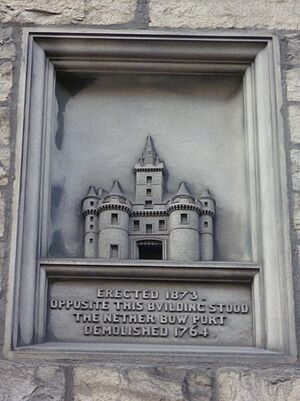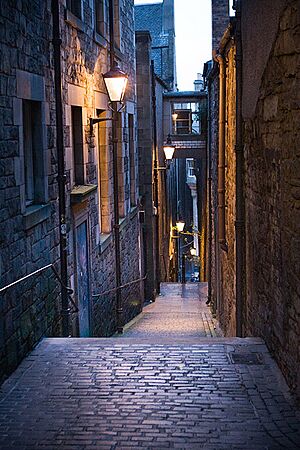Royal Mile facts for kids

The Royal Mile (Scottish Gaelic: Am Mìle Rìoghail) is a famous group of streets in the Old Town of Edinburgh, Scotland. It connects two important places in Scottish history: Edinburgh Castle and Holyrood Palace. The name "Royal Mile" was first used in a book in 1901 and became very popular.
The total distance between the Castle and the Palace is almost exactly one mile (1.6 km). This is how the Royal Mile got its name! The streets that make up the Royal Mile are Castlehill, the Lawnmarket, the High Street, the Canongate, and Abbey Strand. It's one of the busiest streets for tourists in Edinburgh's Old Town.
Contents
Exploring the Royal Mile's Landscape
Many thousands of years ago, melting ice left behind rocks and dirt. This created a special land shape called a "crag and tail." Edinburgh Castle sits on the "crag," which is a hard volcanic rock. The Royal Mile then follows the "tail," which is a ridge that gently slopes down to Holyrood Palace.
The Royal Mile is full of steep, narrow alleyways called closes. These run between tall buildings known as lands or tenements. The street starts at 109 meters (358 feet) above sea level at the Castle and goes down to 42 meters (138 feet) at the Palace. This means it has a gentle slope of about 4.1%.
Castlehill: Gateway to the Castle
The Castle Esplanade is a large open area in front of Edinburgh Castle. It was created in 1753 as a parade ground. Today, it hosts the yearly Royal Edinburgh Military Tattoo, a famous show with music and performances.
One interesting building here is Cannonball House. It has a cannonball stuck in its wall! People often say it was fired from the Castle by accident. But it actually marks the height of a water supply that once fed the Castle.
At the bottom of Castlehill, you'll find The Hub. This building used to be a church and is now the main office for the Edinburgh International Festival. On the other side is the Outlook Tower and Camera Obscura, a fun attraction with optical illusions. The Church of Scotland's Assembly Hall and New College are also nearby. The Scottish Parliament even met in the Assembly Hall for a few years!
Lawnmarket: A Historic Marketplace
The Lawnmarket is a special part of the High Street. It runs from West Bow to St Giles Street. In 1477, this area was named a marketplace for local goods. Things like yarn, stockings, and cloth were sold here. Later, linen became the main product, which is why it was called the "Land Market." This name later changed to "Lawn Market."
Today, the Lawnmarket has many shops for tourists. On the north side, you can see Gladstone's Land. This is a well-preserved 17th-century merchant's house, now owned by the National Trust for Scotland.
The Lawnmarket meets George IV Bridge and Bank Street. Bank Street leads to The Mound and Edinburgh's New Town. The Bank of Scotland's main building stands at the end of Bank Street.
High Street: The Heart of the Royal Mile

The High Street is the longest part of the Royal Mile. About a third of the way down from the Castle, you'll find Parliament Square. This square is named after the old Parliament House. This building was once home to both the law courts and the old Parliament of Scotland until 1707. Now, it houses the Court of Session, Scotland's highest civil court.
St Giles' Cathedral, Edinburgh's main church, also stands in Parliament Square. Near its West Door is the Heart of Midlothian. This is a heart-shaped design built into the road. It marks where the Old Tolbooth prison used to be. Locals often spit on the heart as a sign of disrespect for the old prison.
Across from St Giles', you'll see Edinburgh City Chambers, where the City of Edinburgh Council meets. On the south side, past the church, is the Mercat Cross. Royal announcements and Parliament meetings were once declared from here.
A big fire in 1824, called the Great Edinburgh Fire, damaged many buildings on the south side of the High Street. They were rebuilt in a Georgian style.
The middle of the Royal Mile has a major intersection with the Bridges. North Bridge goes north over Waverley station to Princes Street in the New Town. South Bridge goes south over the Cowgate, a street in a valley below. It continues as Nicolson Street past the Old College of the University of Edinburgh.
Near John Knox House, the High Street gets narrower. This part was once called the Netherbow. It marked the old city boundary. Here stood the Netherbow Port, a fortified gate that was removed in 1764. Brass markers in the road show where it used to be.
After a battle in 1513, a city wall called the Flodden Wall was built around Edinburgh. The Netherbow Port was a gate in this wall. The World's End Pub is on the corner of St Mary's Street. It gets its name from World's End Close, because in old times, this was the last alleyway in Edinburgh before you entered the Canongate.
Canongate: The Canons' Way
Beyond the crossroads, the Royal Mile continues down the Canongate. This name means "the canons' way." It was used by the Augustinian canons of Holyrood Abbey long ago.
This street goes downhill past Moray House, which is now part of the University of Edinburgh. You'll also see the Canongate Tolbooth, which is now a museum called The People's Story Museum. The Canongate Kirk, a local church, is also here. The modern Scottish Parliament Building is located further down, leading to Holyrood Palace and the ruined abbey. Until 1856, the Canongate was a separate town from Edinburgh!
Abbey Strand: The Palace Approach
This short street leads directly to Holyrood Palace at the very end of the Royal Mile. On the south side is the Queen's Gallery. This gallery shows items from the Royal collection. You can also see parts of the old gatehouse of Holyrood Palace, built by King James IV. It has a copy of the royal coat-of-arms of King James V on its wall.
The Royal Mile Today
Today, the Royal Mile is a lively mix of shops, restaurants, pubs, and attractions. During the yearly Edinburgh Festival Fringe, the High Street becomes very crowded. It fills with tourists, street performers, and musicians. Parliament Square remains important as the center of Scotland's legal system.
See also
 In Spanish: Royal Mile para niños
In Spanish: Royal Mile para niños




